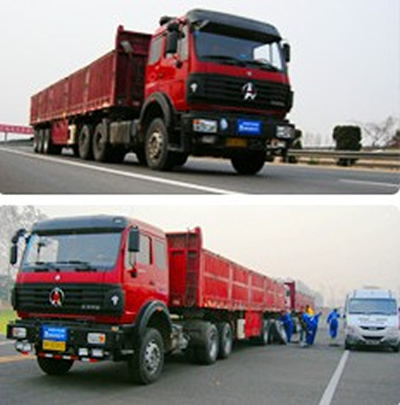Stainless Steel Ball Bearing,Hinges Stainless Steel Ball Bearing,1 Inch Stainless Steel Ball Bearing LBR Bearing Co., Ltd. , http://www.jn-rollerBearings.com
Recently, Michelin's Joint Ministry of Transport, Automotive Trailer Quality Supervision, Inspection and Testing Center announced the test of the Michelin Card Bus series of fuel-efficient tires . According to Minister Yang of the Automotive Trailer Quality Supervision, Inspection and Testing Center of the Ministry of Transport, this test refers to GB/T12534-1990 "General Rules for Automotive Road Test Methods" and GB/T2977-2008 "Heavy Load Vehicle Tire Specifications, Dimensions, Pressure and Load". , GB/T12545.2 "Commercial Vehicle Fuel Consumption Experimental Methods" to develop an experimental program, using two CA4250P66K2T1A1EX type tractors with the same or similar parameters as a sample vehicle. The use of high-precision speedometer and host, flow meters, meteorological instruments, fuel density meter and other standard test equipment. During the test, the test car measurements were divided into two groups. Contrasting tests were performed using Michelin fuel oil tires and Michelin tires . 
First, tests were carried out on inner tires of “normal tires †and “economized tires, †followed by tests on tireless “normal tires †and “economized tires .†The sample car is warmed up for 30km at a speed of 60km/h. After the preheating is completed, the fuel consumption of the sample vehicle A and sample vehicle B at a constant speed of 60km/h through a distance of 5km is measured at the same time (continuous measurement 3 times); Simultaneously measure the fuel consumption of sample car A and sample car B running at a constant speed of 60km/h over 50km. Exchange the tires of two kinds of vehicles, warm up again for 30km at a speed of 60km/h, and then measure the fuel consumption according to the above procedure. In this test process, the final result is relatively accurate.
Michelle Card Passenger Car Tyre Department customer experience manager Zhang Hongbing said, “We have also used a full-tank method for comparison tests among users, and the effect of fuel saving is also good. Through this precise test, it also explains the reality of Michelin oil tires . "Effectively," "Now that oil prices have been stubbornly high, vehicle operators are under increasing pressure, fuel-efficient tires can effectively help users reduce their expenditures. It's a staggering number, and oil prices will always be upward in the long run." "The trend will be more cost savings in the future." For a vehicle with a fuel consumption of 35 liters per 100 kilometers and 200,000 kilometers per year, the use of fuel-efficient 4% Michelin tires will be calculated at a diesel price of 7.5 yuan per liter per year. Saving 21,000 yuan, for a fleet of 50 vehicles, it can save 1.05 million yuan / year. When this is a highlight of this year's business, Zhang Hongbing said: “This year, Michelin focused on the promotion of fuel-efficient products. With the introduction of fuel-efficient products, we are now able to provide various mainstream sizes and full-scale fuel savings that include inner tubes and tubeless tubes. Products, including fuel-efficient products for axles and trailer axles, and fuel-efficient products for driveshafts , have been introduced this year, and we have introduced reinforced tires this year with better performance in terms of strength, performance, and low failure rate after the 2008 financial crisis. There are many uncertainties in the world economy. Michelin believes that users need more fuel-efficient, environmentally friendly and economical products. This is Michelin's advantage."
As for the effect of fuel-efficient tires on fuel economy, Michel Berenz, product marketing manager of the Michelin Truck & Bus tires department, demonstrated it through a small experimental device. Two small rubber wheels of the same size, one with a common tire compound and one with a fuel-efficient tire compound. When the two rubber wheels are oscillated at the same time, the rubber wheel using the fuel-saving tire rubber formula can swing for a longer time, which means that the rolling resistance of the rubber wheel is even smaller. The tire rolling resistance consumes approximately 35% of the fuel required for vehicle operation. Every 3%~5% reduction in rolling resistance is intended to reduce the fuel consumption by about 1%. Therefore, in order to reduce the rolling resistance, the Michelin tire industry began addition of silicon known as "white carbon black" in the compound formulation in 1992, the tire can be more fuel efficient. Taking the Michelin 12R22.5 X Coach Energy XZ tire as an example, it adopts a special compound formula containing silicon, which has the features of long mileage, energy-saving efficiency, safety and comfort. In two days the Ministry of Transportation Highway Traffic closed beta test site held in Michelin fuel-efficient fuel-efficient tire inner tubes, tubeless tire fuel-efficient tires save fuel, respectively, than the average 3.8% and 4.5%, fuel-saving effect is remarkable.
With more stringent restrictions on vehicle fuel consumption, rising oil prices, and the needs of fleets and users, the industry has paid great attention to various fuel-saving solutions. Tyres play a pivotal role in the operation of the vehicle, especially in terms of safety and fuel economy. It is understood that the fuel consumption of the tires accounts for 1/3 of the total number of passengers travelling on the bus. In the cost structure of the transportation industry, tires account for about 6% of the total cost, and fuel costs account for as much as 40%. With the continuous rise in fuel prices, this proportion is still further increased.
Michelin Tire Joint Transport Department for Fuel Saving Test